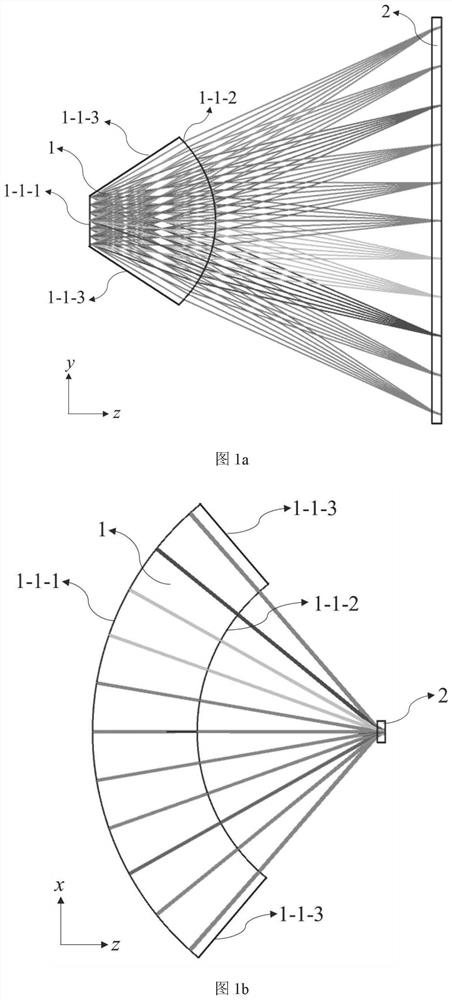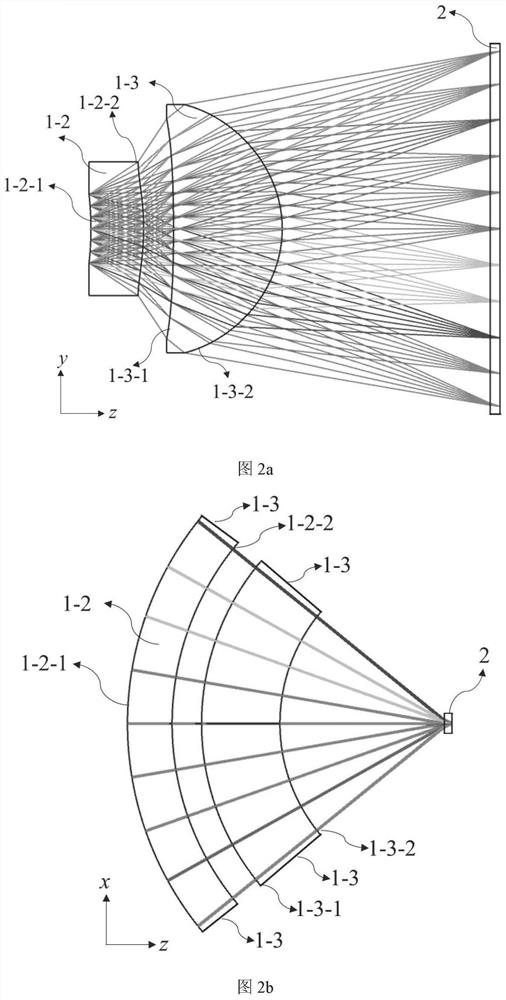Optical space positioning system and space positioning method thereof
A spatial positioning and optical technology, which is applied in the field of optical engineering and sensing, can solve the problems of small field of view, cumbersomeness, and small detection range of the photoelectric position detection, and achieves diversification of detection range, reduction of the number of lenses, and weight reduction. Effect
- Summary
- Abstract
- Description
- Claims
- Application Information
AI Technical Summary
Problems solved by technology
Method used
Image
Examples
Embodiment 1
[0031] see figure 1 , an optical space positioning system, comprising a toroidal lens 1 and a linear array photosensitive element 2, the toroidal lens 1 and the linear array photosensitive element 2 constitute a detection unit, and at least three detection units are distributed in different positions in space , and the direction of the line photosensitive element 2 in at least one unit is not parallel to the direction of the line photosensitive element 2 in other units, forming a complete spatial positioning system.
[0032] The optical spatial positioning system of this embodiment can not only detect a small range of angles, but also be suitable for positioning operations within a detection range of a wide range of angles. Therefore, the optical spatial positioning system of this embodiment has wider adaptability in detection range angles. At the same time, the optical spatial positioning system of this embodiment can especially realize high-precision positioning within a la...
Embodiment 2
[0034] This embodiment is basically the same as Embodiment 1, and the special features are as follows:
[0035] In this embodiment, the toroidal lens has two optical surfaces, each of which takes the center of the line array photosensitive element 2 as the center of rotation, and the combination of the two optical surfaces can focus the light beam onto the line array photosensitive element 2 , the linear photosensitive element 2 is composed of micron-scale photosensitive pixels arranged in a straight line.
[0036] In this embodiment, the toroidal lens 1 is composed of one lens, or is composed of two toroidal lenses 1-2 and 1-3, or is composed of more than two toroidal lenses, each of which All the toroids take the center of the line photosensitive element 2 as the center of rotation.
[0037] In this embodiment, the combination of the optical surfaces of the toroidal lens 1 can focus light beams onto the linear photosensitive element 2 .
[0038] The optical space positioni...
Embodiment 3
[0041] This embodiment is basically the same as the above-mentioned embodiment, and the special features are as follows:
[0042]A space positioning method using the above-mentioned optical space positioning system, the operation steps are as follows:
[0043] Step 1, the toroidal lens 1 is equivalent to a circular arc, and the position of the pixel point illuminated by the light of the linear array photosensitive element 2 is obtained, and the point and the circular arc form a conical surface;
[0044] Step 2. At least three cone surfaces intersect at one point in space; the position of the point is calculated by solving the cone surface equations, which is the position of the detected point.
[0045] This embodiment can realize the high-precision detection function of a wide range of spatial positions, and the cost is low.
PUM
 Login to View More
Login to View More Abstract
Description
Claims
Application Information
 Login to View More
Login to View More - R&D
- Intellectual Property
- Life Sciences
- Materials
- Tech Scout
- Unparalleled Data Quality
- Higher Quality Content
- 60% Fewer Hallucinations
Browse by: Latest US Patents, China's latest patents, Technical Efficacy Thesaurus, Application Domain, Technology Topic, Popular Technical Reports.
© 2025 PatSnap. All rights reserved.Legal|Privacy policy|Modern Slavery Act Transparency Statement|Sitemap|About US| Contact US: help@patsnap.com



